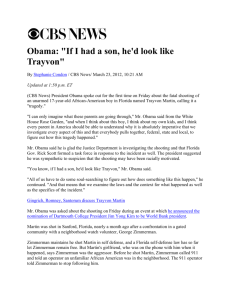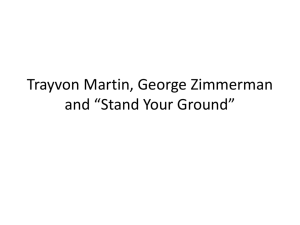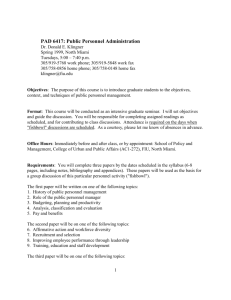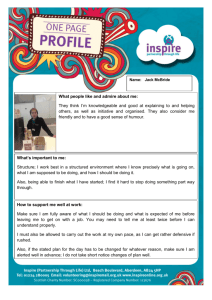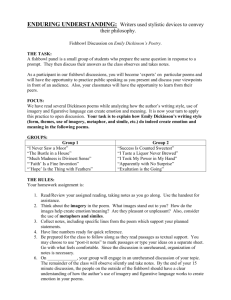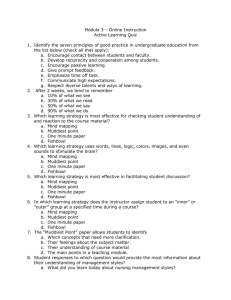self-defense and racial profiling - Anti
advertisement
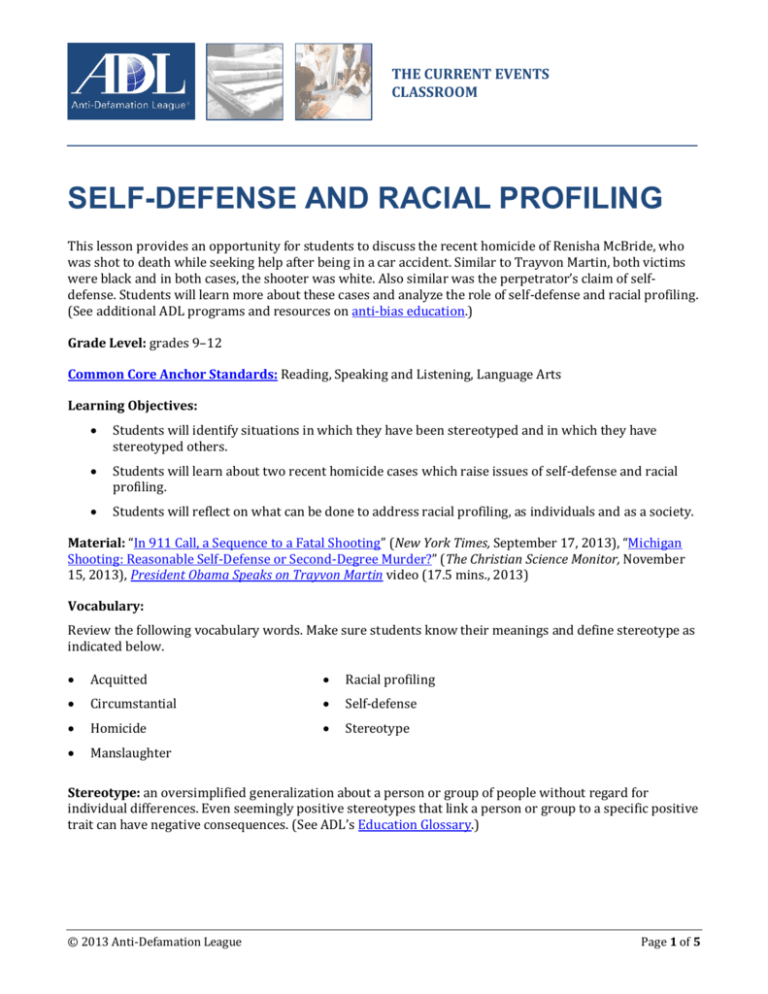
THE CURRENT EVENTS CLASSROOM SELF-DEFENSE AND RACIAL PROFILING This lesson provides an opportunity for students to discuss the recent homicide of Renisha McBride, who was shot to death while seeking help after being in a car accident. Similar to Trayvon Martin, both victims were black and in both cases, the shooter was white. Also similar was the perpetrator’s claim of selfdefense. Students will learn more about these cases and analyze the role of self-defense and racial profiling. (See additional ADL programs and resources on anti-bias education.) Grade Level: grades 9–12 Common Core Anchor Standards: Reading, Speaking and Listening, Language Arts Learning Objectives: Students will identify situations in which they have been stereotyped and in which they have stereotyped others. Students will learn about two recent homicide cases which raise issues of self-defense and racial profiling. Students will reflect on what can be done to address racial profiling, as individuals and as a society. Material: “In 911 Call, a Sequence to a Fatal Shooting” (New York Times, September 17, 2013), “Michigan Shooting: Reasonable Self-Defense or Second-Degree Murder?” (The Christian Science Monitor, November 15, 2013), President Obama Speaks on Trayvon Martin video (17.5 mins., 2013) Vocabulary: Review the following vocabulary words. Make sure students know their meanings and define stereotype as indicated below. Acquitted Racial profiling Circumstantial Self-defense Homicide Stereotype Manslaughter Stereotype: an oversimplified generalization about a person or group of people without regard for individual differences. Even seemingly positive stereotypes that link a person or group to a specific positive trait can have negative consequences. (See ADL’s Education Glossary.) © 2013 Anti-Defamation League Page 1 of 5 The Current Events Classroom adl.org/curriculum-resources TURN AND TALK: ASSUMPTIONS AND STEREOTYPES Have students take a few minutes to think about a time when someone made an assumption about them based on an aspect of their identity (e.g. gender, race, ethnicity, sexual orientation, religion, socioecomonic class, etc.), either real or perceived. Review the definition of stereotype. Give an example such as: you are followed around a store because you are a teenager. The store owner assumes you may steal something because he or she assumes most teenagers steal. Then, in pairs, have students share their stories and describe the assumption/stereotype and how it made them feel to be perceived in that way. Ask for a few students to share their experiences with the larger group. INFORMATION SHARING 1. Ask students: Has anyone heard of Renisha McBride? If they have, ask them to share what they know. Give a brief summary about Renisha McBride’s recent death: Renisha McBride: On November 2, 2013, Renisha McBride, a young black 19 year-old woman, crashed the car she was driving along a residential street in Detroit’s west side. Witness accounts report that she appeared disoriented and troubled. A 911 caller said she returned to the scene of the accident and seemed intoxicated. Several hours later and six blocks away, just outside the Detroit city limits in a mostly White suburb, Renisha McBride was shot dead on the front porch of a stranger’s home, by a shotgun blast to her face. The timing of the events is still unclear. Toxicology results showed that her blood alcohol was more than two times the legal limit for driving. Civil rights activists have been protesting in Detroit. After a two-week investigation, the homeowner was charged with second degree murder. NOTE: Another similar and recent case involved the death of Jonathan Ferrell in North Carolina, who was shot under similar circumstances. If your students mention him, here is more information about the case: “In 911 Call, a Sequence to a Fatal Shooting.” 2. Ask: What questions do you have? What more do you want to know about this? How did you feel hearing this? What do you think happened? READING ACTIVITY 1. Give students 10 minutes to read “Michigan Shooting: Reasonable Self-Defense or Second-Degree Murder?” to learn more about the Renisha McBride case. 2. After reading the article, lead a group discussion, using the following questions: What new information did you learn from the article? What role did self-defense, if any, play in the case? How does the state of Michigan define self-defense? Do you think the shooting was racially motivated? Why or why not? Is it relevant that she may have been drunk? 3. Next, ask: Has anyone heard of Trayvon Martin? Have students share what they know and then give details about the case: © 2013 Anti-Defamation League Page 2 of 5 The Current Events Classroom adl.org/curriculum-resources Trayvon Martin: In February 2012, Trayvon Martin, a 17 year-old teenager in Florida, was shot by George Zimmerman, a neighborhood watch volunteer. Trayvon was unarmed and on his way home after buying some snacks from the store. George called 911 to report “a suspicious person” in the neighborhood; when asked if he was following Trayvon, he said yes and the 911 operator said, “Ok, we don’t need you to do that.” George disregarded those instructions and approached Trayvon, later saying that Trayvon knocked him to the ground, punched him and slammed his head repeatedly against the sidewalk. Claiming he acted in self-defense, George said this is why he shot Trayvon. The prosecution contended that George had deliberately pursued Trayvon because he assumed the hoodie-clad Black teenager was a criminal and instigated the fight that led to his death. Initially, George Zimmerman was not charged with a crime but after continued protests and public outcry, he was tried and eventually acquitted. The case ignited a national debate on racial profiling and civil rights, and President Obama spoke about the case after the verdict, which students will view later. 4. Ask: Now that you’ve learned more about the Renisha McBride case and reviewed what happened with Trayvon Martin, what is similar about these cases? Then ask: What are the differences between these two cases? Represent where they overlap and where they don’t in a chart like the one below. RENISHA MCBRIDE AND TRAYVON MARTIN CASES Similarities Both victims were black, young people Both victims were unarmed Both perpetrators claimed self-defense Civil rights’ activists claimed that the crimes were racially motivated Differences Renisha McBride case arrest made quickly (within 2 weeks) as opposed to Trayvon Martin case (almost 2 months) Renisha McBride homicide took place in someone’s home, Trayvon Martin was on the street FISHBOWL The purpose of using a fishbowl strategy is to have a large group of students listen to the experiences and perspectives of a smaller group of students. 1. Ask for 5–7 volunteers who are willing to talk about stereotyping and their thoughts and feelings about these cases. Have those students bring their chairs into the middle of the classroom and form a circle. The rest of the students, the “observers,” should sit in chairs around them in a larger circle. 2. Facilitate the small group discussion. Guide the conversation with the questions below, making sure everyone in the fishbowl has an opportunity to talk. During the fishbowl, observers are not allowed to speak; their task is to listen and learn. Use these questions (or come up with your own) for the fishbowl: Has anyone ever made a generalization or stereotype about you because of some aspect of your identity? What happened? How did you feel? Have you ever made an assumption or held a stereotype about someone or a group of people? What happened? How did you feel? After reflecting on this case and reflecting on the Trayvon Martin case, do you think race or racial profiling played a role in the victims’ deaths? How so? © 2013 Anti-Defamation League Page 3 of 5 The Current Events Classroom adl.org/curriculum-resources What do you think can be done about stereotyping and racial profiling? 3. After 10–15 minutes of fishbowl discussion, time permitting, inform the observers they may now join the fishbowl. Instruct the observers who wish to speak to tap the shoulder of someone in the fishbowl and take their seat. That person in the fishbowl should leave the fishbowl and take the person’s seat who tapped their shoulder. They can either respond to what they heard during the fishbowl or answer any of the fishbowl questions. 4. After the fishbowl is completed, engage students in a whole class discussion by asking the following: How was the fishbowl activity for you? For the observers, was it difficult not to respond during the fishbowl? For the fishbowl students, how did it feel to share your feelings with the small group? Was anything said that surprised you? What did you learn from the experience? ACTION: WHAT CAN WE DO ABOUT RACIAL PROFILING View the video President Obama Speaks on Trayvon Martin, a statement by President Obama about Trayvon Martin and the verdict that followed his death. After watching the video, engage students in a discussion by asking: Why did President Obama say “Trayvon Martin could have been me?” What were some examples President Obama used to illustrate how he and others have been racially profiled? What are your reactions to this? What did President Obama say about how we, as a society and as individuals, can address racial profiling? Do you have any additional ideas? What did President Obama mean when he said, “All of us need to do some soul-searching.”? CLOSING Ask: What is one thing you think can be done about stereotyping or racial profiling? ADDITIONAL READING Killing, With the Law On Your Side (New York Times, March 21, 2012) Renisha McBride Shooting: Ways It Is and Isn't Like Trayvon Martin Case (The Christian Science Monitor, November 12, 2013) In Detroit, Protests of Shooting of Woman Who Sought Help (New York Times, November 10, 2013) Murder Charge in a Shooting on Doorstep (New York Times, November 15, 2013) Renisha McBride’s Family Seeks Justice For Daughter’s Shooting (The Huffington Post, November 16, 2013) © 2013 Anti-Defamation League Page 4 of 5 The Current Events Classroom adl.org/curriculum-resources COMMON CORE ANCHOR STANDARDS R.1 Read closely to determine what the text says explicitly and to make logical inferences from it; cite specific textual evidence when writing or speaking to support conclusions drawn from the text. R.7 Integrate and evaluate content presented in diverse media and formats, including visually and quantitatively, as well as in words. SL.1 Prepare for and participate effectively in a range of conversations and collaborations with diverse partners, building on others’ ideas and expressing their own clearly and persuasively. SL.3 Evaluate a speaker’s point of view, reasoning, and use of evidence and rhetoric. L.4 Determine or clarify the meaning of unknown and multiple-meaning words and phrases by using context clues, analyzing meaningful word parts, and consulting general and specialized reference materials, as appropriate. © 2013 Anti-Defamation League Page 5 of 5
